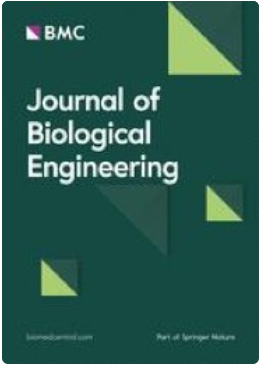3D-printed PCL@BG scaffold integrated with SDF-1α-loaded hydrogel for enhancing local treatment of bone defects
IF 5.7
3区 生物学
Q1 BIOCHEMICAL RESEARCH METHODS
引用次数: 0
Abstract
The long-term nonunion of bone defects is always a difficult problem in orthopaedics treatment. Artificial bone implants made of polymeric materials are expected to solve this problem due to their suitable degradation rate and good biocompatibility. However, the lack of mechanical strength, low osteogenic induction ability and poor hydrophilicity of these synthetic polymeric materials limit their large-scale clinical application. In this study, we used bioactive glass (BG) (20%, W/W) and polycaprolactone (PCL, 80%, W/W) as raw materials to prepare a bone repair scaffold (PCL@BG20) using fused deposition modelling (FDM) three-dimensional (3D) printing technology. Subsequently, stromal cell-derived factor-1α (SDF-1α) chemokines were loaded into the PCL@BG20 scaffold pores with gelatine methacryloyl (GelMA) hydrogel. The experimental results showed that the prepared scaffold had a porous biomimetic structure mimicking that of cancellous bone, and the compressive strength (44.89 ± 3.45 MPa) of the scaffold was similar to that of cancellous bone. Transwell experiments showed that scaffolds loaded with SDF-1α could promote the recruitment of bone marrow stromal cells (BMSCs). In vivo data showed that treatment with scaffolds containing SDF-1α and BG (PCL@BG-GelMA/SDF-1α) had the best effect on bone defect repair compared to the other groups, with a large amount of new bone and mature collagen forming at the bone defect site. No significant organ toxicity or inflammatory reactions were observed in any of the experimental groups. The results show that this kind of scaffold containing BG and SDF-1α serves the dual functions of recruiting stem cell migration in vivo and promoting bone repair in situ. We envision that this scaffold may become a new strategy for the clinical treatment of bone defects.集成了 SDF-1α 水凝胶的 3D 打印 PCL@BG 支架,可增强骨缺损的局部治疗效果
骨缺损的长期不愈合一直是骨科治疗中的难题。高分子材料制成的人工骨植入物因其适宜的降解率和良好的生物相容性,有望解决这一问题。然而,这些合成高分子材料缺乏机械强度、成骨诱导能力低、亲水性差,限制了它们在临床上的大规模应用。在本研究中,我们以生物活性玻璃(BG,20%,W/W)和聚己内酯(PCL,80%,W/W)为原料,采用熔融沉积建模(FDM)三维(3D)打印技术制备了骨修复支架(PCL@BG20)。随后,用甲基丙烯酰明胶(GelMA)将基质细胞衍生因子-1α(SDF-1α)趋化因子载入 PCL@BG20 支架孔中。实验结果表明,所制备的支架具有模仿松质骨的多孔仿生结构,其抗压强度(44.89 ± 3.45 兆帕)与松质骨相似。透孔实验表明,载入 SDF-1α 的支架能促进骨髓基质细胞(BMSCs)的募集。体内数据显示,与其他组别相比,含有 SDF-1α 和 BG 的支架(PCL@BG-GelMA/SDF-1α)对骨缺损修复的效果最好,骨缺损部位有大量新骨和成熟胶原形成。各实验组均未观察到明显的器官毒性或炎症反应。结果表明,这种含有 BG 和 SDF-1α 的支架具有招募体内干细胞迁移和促进原位骨修复的双重功能。我们设想,这种支架可能成为临床治疗骨缺损的一种新策略。
本文章由计算机程序翻译,如有差异,请以英文原文为准。
求助全文
约1分钟内获得全文
求助全文
来源期刊

Journal of Biological Engineering
BIOCHEMICAL RESEARCH METHODS-BIOTECHNOLOGY & APPLIED MICROBIOLOGY
CiteScore
7.10
自引率
1.80%
发文量
32
审稿时长
17 weeks
期刊介绍:
Biological engineering is an emerging discipline that encompasses engineering theory and practice connected to and derived from the science of biology, just as mechanical engineering and electrical engineering are rooted in physics and chemical engineering in chemistry. Topical areas include, but are not limited to:
Synthetic biology and cellular design
Biomolecular, cellular and tissue engineering
Bioproduction and metabolic engineering
Biosensors
Ecological and environmental engineering
Biological engineering education and the biodesign process
As the official journal of the Institute of Biological Engineering, Journal of Biological Engineering provides a home for the continuum from biological information science, molecules and cells, product formation, wastes and remediation, and educational advances in curriculum content and pedagogy at the undergraduate and graduate-levels.
Manuscripts should explore commonalities with other fields of application by providing some discussion of the broader context of the work and how it connects to other areas within the field.
文献相关原料
公司名称
产品信息
索莱宝
DAPI
阿拉丁
PCL
 求助内容:
求助内容: 应助结果提醒方式:
应助结果提醒方式:


